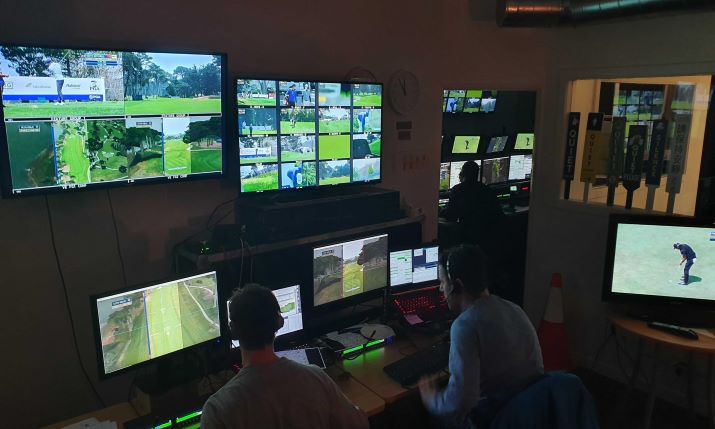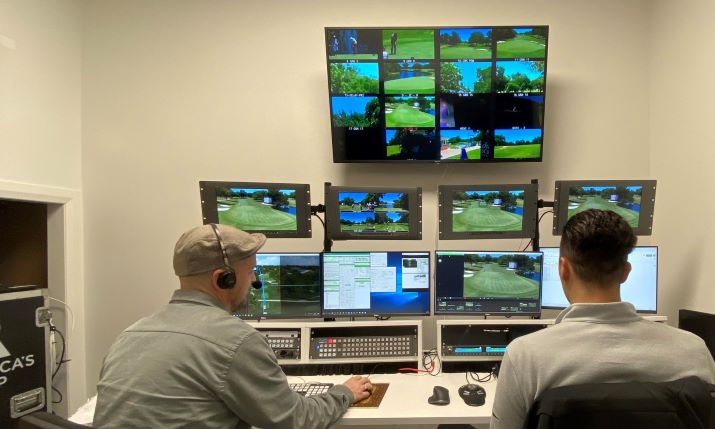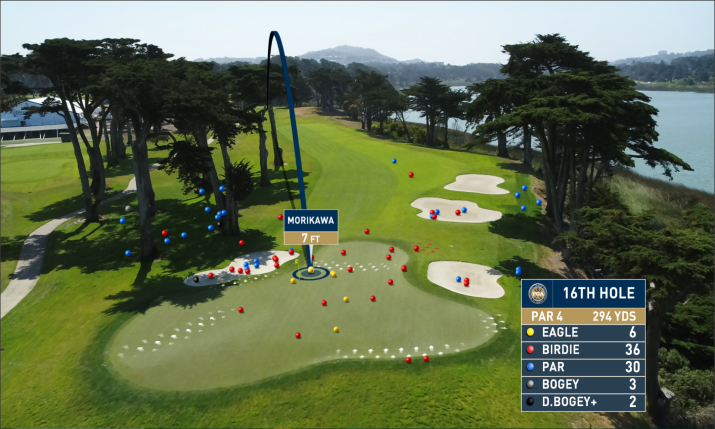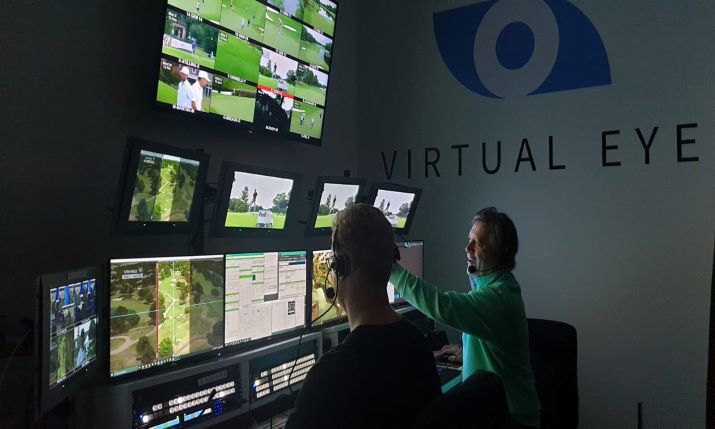Virtual Eye takes 3D graphics production for sports broadcasting remote over summer

The Virtual Eye team working in an extension temporarily put in place for the PGA Championship 2020 at its base in Dunedin, New Zealand
Virtual Eye, the sports division of New Zealand-based Animation Research, which is one of Australasia’s main 3D computer graphics production houses, has used Amazon Web Services (AWS) to enable its continued global sports broadcasting work during lockdown.
For more than 25 years, Emmy Award-winning Virtual Eye has specialised in 3D TV graphics that change the way fans watch high profile sports, and has delivered those experiences on multiple platforms for events such as the Ryder Cup, The Open Championship (The British Open), the US Open, the America’s Cup, Formula 1, The Olympics, World Rally, Red Bull Freeride Tour, The Ashes, and both the PGA and European golf tours.
Normally Virtual Eye’s teams travel around the world to provide on-site production support and create 3D graphics that help broadcasters deliver compelling stories to viewers as sports action unfolds.
In golf alone, Animation Research and Virtual Eye cover more than 90 tournaments a year across Europe, Asia, the Middle East, Africa and the US, and have an average of 30 projects under way at any given time. “Helping sports programmers share great stories with fans is in our blood,” said John Rendall, head of technology and innovation at Animation Research.
2020 and the pandemic presented a challenge for Virtual Eye, which traditionally deployed crews of up to 12 people to locations around the world for on-site production.
“More than 80% of our annual revenue is driven through our sports focused business (Virtual Eye),” said Ian Taylor, managing director at Animation Research. “When COVID-19 hit, we were faced with the daunting prospect of ‘what’s next?’”

Virtual Eye’s main golf operators, Reece Witters and Eliott Smith, in Dunedin
Early on in the pandemic, it became a major risk to have operators roaming around the world, and also countries including New Zealand were starting to close borders. Rendall and his tech team had to work out how Animation Research could continue to deliver to its clients when sporting events around the world resumed, without the team on site.
“We had to devise a platform that would allow us to do everything remotely from New Zealand. The flexibility, scalability, and security of AWS was the answer we needed for cloud-based remote production operations,” said Rendall.
“Other platforms were complicated to use,” Rendall added. “Having access to off-the-shelf services, a good set of APIs in order to access them and fine applications to go with them has really made a difference for us. That is a really big benefit for a company that has to move as quickly as we do. We have 30 to 40 projects going at any one time, and, because we’re a relatively small company, we need to be able to find products and service that can deliver what we need with the minimal effort.”
Now, by leveraging the AWS-powered architecture, Animation Research provides a high capacity bridge between remote on-site productions and Virtual Eye offices in Dunedin, New Zealand, without having to deploy crew to manage operations at multiple remote sports venues.
Using AWS global infrastructure and services, including AWS Elemental MediaConnect, Virtual Eye is able to provide full, virtual operations management. This enables broadcasters to deliver live video from remote locations and provide secure exchanges of live video feeds between sports venues and central operations in New Zealand with minimal latency to ensure optimal viewing experiences.

Virtual Eye gives the PGA Championship 2020 the virtual graphics treatment from afar
To further assure secure content delivery over its network, Animation Research uses AWS Virtual Private Cloud with site-to-site VPN and AWS Global Accelerator, a managed service that improves the availability and performance of applications with local or global users to meet broadcasting standards.
“I don’t have a technical background,” said Taylor, “but as soon as John showed me what Media Connect could deliver to solve this problem we had, it was a no-brainer for me. Moving video around the globe is always challenging and expensive, whether you were using satellite links or dark fibre lines. Media Connect allows companies like us and a lot of broadcasters to do this without the huge costs associated with it previously. AWS has such a good array of services. And a lot of our customers are using the same tools we are.”
The AWS architecture was put to the test at one of the first sporting events back after the initial COVID-19 shutdown, the Charles Schwab Challenge PGA golf event in Dallas-Fort Worth, Texas. From 7,500 miles away, Virtual Eye provided CBS Sports with augmented reality, virtual ball tracking and other graphic elements, rendered in real time, for the enjoyment of fans at home.
“The system worked flawlessly,” said Rendall. “We have now delivered every tournament for the past three months and we are currently gearing up for both the US Open and The Masters.”
Meanwhile, Taylor noted: “Because we built our platform around AWS, it’s opened up new doors of opportunity for us. We are at the other end of the world and we still are able to reach distant places thanks to AWS. If we can do it from here, we can do it from anywhere. That’s the kind of reliability and confidence we can now provide our clients.

Virtual Eye operator, Angus Reid and Ian Taylor, managing director at Animation Research, hard at work in Dunedin, New Zealand
“Additionally, AWS is accelerating our speed of innovation into machine learning use cases, giving us the ability to automatically track players in the field using a machine learning vision to provide a wealth of insights and analytics to different stakeholders from viewers to coaching staff,” he continued.
Both Rendall and Taylor also saw the AWS cloud video infrastructure as an opportunity for Virtual Eye to reduce its carbon footprint. “We originally planned to deploy a more sustainable model for remote production three to four years from now,” said Taylor. “Due to COVID-19, we accelerated our sustainability initiative. With the help of AWS, we are able to support multiple simultaneous remote productions without having to deploy large crews and to reduce crew size by an average of more than 80 percent for multi-day events.”
Taylor added that his company is now creating an educational platform to be given free to all schools in New Zealand, inspired by a video called ‘Papatuānuku Breathes’, which was released in New Zealand during COVID-19.
“Sustainability is very important to us,” he noted. “Papatūānuku is our Earth Mother and she has been giving us messages. Just one example, during the pandemic she has shown us how quickly she can clean the air we breathe, if we don’t fly or drive as much. The real question is ‘will we listen to her now?’
“By its very nature as a cloud technology provider, AWS is adamant about sustainability and so are we so it’s been a nice fit,” Taylor concluded. “AWS, including AWS Media Services, has become our valued partner, innovating on two fronts: remote production and sustainability. Remote production operations is our way of listening to Papatūānuku.”

